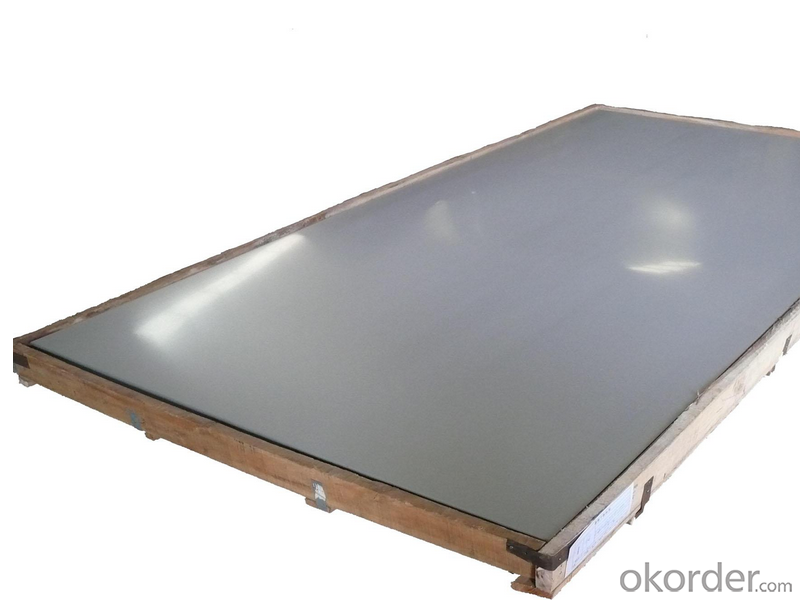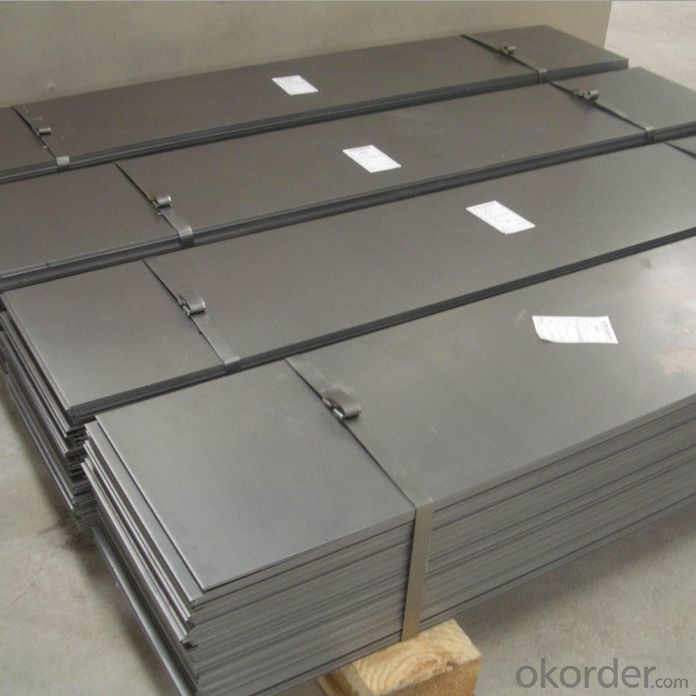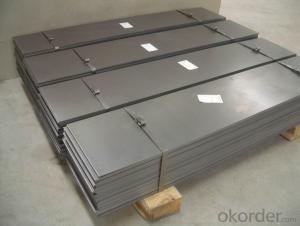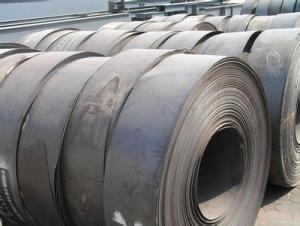Stainless Steel Plate ASTM Standard 200,300,400 Series
- Loading Port:
- China main port
- Payment Terms:
- TT or LC
- Min Order Qty:
- 50 m.t.
- Supply Capability:
- 1000 m.t./month
OKorder Service Pledge
OKorder Financial Service
You Might Also Like
1.Structure of Stainless Steel Plate Description
Be used in manufacture of medical equipment, auto parts, heat-resistant kitchen utensils, electrical accessories , construction decoration ,etc.The surface brightness and flatness of no2B is better than no2D. then through a special
surface treatment to improve its mechanical properties,No2B could nearly satisfy comprehensive uses.
2.Main Features of the Stainless Steel Plate
• Decoration
• Daily Necessities
•,Medical Treatment
• Daily Necessities
3. Stainless Steel Plate Images


4. Stainless Steel Plate Specification
Product Name | ASTM Standard 200,300,400 Series Stainless Steel Plate |
Standard | JIS AISI ASTM GB DIN |
Grade | 200/300/400 Series |
Thickness | 0.2mm-100mm |
Width | 100mm-2000mm |
Length | According to clients’ requirement |
Surface Finish | 2B ,BA ,8K ,NO4,NO2, NO1 ,Hair line ,EMBOSSED... |
Technique | Cold rolled ,Hot rolled |
Package | Seaworthy packing or as the consumers’ demand |
Application | Be used in manufacture of medical equipment, auto parts, heat-resistant kitchen utensils, electrical accessories , construction decoration ,etc |
5.FAQ of Stainless Steel Plate
①Who are you?
We are the manufacturer! We produce stainless steel products
with high quality & very competitive price!Please feel free to
contact us for more information!
②How long can we receive the product after purchase?
In the purchase of product within three working days, We will arrange the factory delivery as soon as possible. The pecific time of receiving is related to the state and position of customers.Commonly 7 to 10 working days can be served.
③How about your company?
A world class manufacturer & supplier of castings forging in Stainless Steel Sheet,is one of the large-scale professional investment casting production bases in China,consisting of both casting foundry forging and machining factory. Annually more than 8000 tons Precision casting and forging parts are exported to markets in Europe,America and Japan. OEM casting and forging service available according to customer’s requirements.
- Q:What are the common surface finishes for galvanized steel strips?
- Galvanized steel strips can be finished in various ways, with some common options including: 1. Regular Spangle: This finish displays a shiny, crystalline pattern on the surface. It occurs naturally during the galvanization process when the zinc coating solidifies. 2. Mini Spangle: Smaller and closely spaced spangles characterize this finish, giving it a smoother and more uniform appearance compared to the regular spangle. 3. Zero Spangle: This finish lacks visible spangles, resulting in a matte or dull appearance. It is achieved by applying a special chemical treatment during galvanization. 4. Skin Pass: By passing the galvanized steel strip through rollers that compress and flatten the surface, this finish improves the strip's flatness and smoothness. 5. Bright Finish: A thin, transparent organic coating is applied over the galvanized surface to achieve this finish. It not only enhances the aesthetics but also provides additional protection against corrosion. It is worth noting that the choice of surface finish for galvanized steel strips depends on the specific application and requirements.
- Q:Can steel strips be used in the production of shipbuilding components?
- Yes, steel strips can be used in the production of shipbuilding components. Steel strips are often used as raw material for manufacturing various shipbuilding components such as hull plates, frames, bulkheads, and other structural elements. The high strength and durability of steel make it an ideal material choice for shipbuilding, ensuring the structural integrity and longevity of the ship.
- Q:How do steel strips handle exposure to moisture?
- Steel strips typically handle exposure to moisture well, especially if they have been properly coated or galvanized. However, prolonged exposure to moisture can lead to corrosion and rust formation on the surface of the steel strip. Regular maintenance and protective measures are necessary to prevent or minimize any potential damage caused by moisture.
- Q:Can steel strips be used in the production of electrical transformers?
- Yes, steel strips can be used in the production of electrical transformers. Steel strips are often used as the core material in transformers due to their magnetic properties, which help to efficiently transfer and transform electrical energy.
- Q:What are the different surface plating methods for steel strips?
- There are several different surface plating methods that can be used for steel strips, depending on the desired outcome and intended application. Some of the most common methods include: 1. Galvanizing: This is a process where steel strips are coated with a layer of zinc to provide corrosion resistance. The steel strips are immersed in a bath of molten zinc or are electroplated with zinc. Galvanizing can be done through hot-dip galvanizing or electro-galvanizing. 2. Electroplating: This method involves coating the steel strips with a layer of metal through an electrochemical process. Common metals used for electroplating include nickel, chrome, tin, and copper. Electroplating can improve corrosion resistance, enhance appearance, and provide wear resistance. 3. Tin plating: This method involves depositing a layer of tin onto the steel strips. Tin plating provides excellent corrosion resistance and is commonly used for food packaging and electronic components. 4. Nickel plating: Nickel plating is a process where steel strips are coated with a layer of nickel. This method provides corrosion resistance, wear resistance, and can improve the appearance of the steel strips. 5. Chromium plating: Chromium plating involves depositing a layer of chromium onto the steel strips. This method provides excellent corrosion resistance, hardness, and improves the aesthetic appeal of the steel strips. It is commonly used for decorative applications and in industries where corrosion resistance is crucial. 6. Organic coating: This method involves applying a protective layer of organic material, such as paint or powder coating, onto the steel strips. Organic coatings provide corrosion resistance, improved appearance, and can be customized for various applications. It is important to consider the specific requirements and conditions of the steel strips' application when choosing the appropriate surface plating method. Each method has its advantages and limitations, and the selection should be based on factors such as corrosion resistance, wear resistance, cost-effectiveness, and aesthetic preferences.
- Q:What are the common surface rust prevention methods for steel strips?
- There are several common surface rust prevention methods for steel strips that effectively protect the material from corrosion. These methods include: 1. Coating with paint: Applying a layer of paint on the surface of steel strips acts as a barrier to prevent moisture and oxygen from coming into contact with the metal. This prevents the formation of rust and extends the lifespan of the steel strips. 2. Galvanizing: Galvanizing is a process where a layer of zinc is applied to the surface of steel strips. Zinc acts as a sacrificial anode, corroding before the steel does. This protects the steel from rusting, even if the zinc layer gets damaged. 3. Electroplating: Electroplating involves the deposition of a thin layer of metal, such as chromium or nickel, onto the surface of steel strips. This creates a protective barrier against rust, enhancing the appearance and durability of the steel. 4. Applying rust inhibitors: Rust inhibitors, also known as rust preventatives or rust converters, are chemical compounds that can be applied to the surface of steel strips. These inhibitors create a protective film over the metal, preventing the formation of rust. 5. VCI (Volatile Corrosion Inhibitors) packaging: VCI packaging involves enclosing steel strips in a material that emits volatile corrosion inhibitors. These inhibitors create a protective atmosphere around the steel, preventing rust formation even in humid conditions. 6. Phosphating: Phosphating is a process where a layer of phosphate coating is applied to the surface of steel strips. This coating improves the adhesion of paint and provides a protective barrier against rust. It is worth noting that the choice of rust prevention method depends on factors such as the intended use of the steel strips, environmental conditions, and budget constraints.
- Q:How do steel strips resist wear and tear?
- Steel strips resist wear and tear due to their high strength and hardness. The composition and processing of steel strips make them highly resistant to abrasion, impact, and deformation, ensuring they can withstand heavy usage and harsh environments without significant damage.
- Q:Can steel strips be used for making electrical connectors in power distribution systems?
- Yes, steel strips can be used for making electrical connectors in power distribution systems. Steel is a commonly used material due to its high strength, durability, and conductive properties. It provides a reliable connection between power cables and ensures efficient transmission of electricity in power distribution systems.
- Q:What are the weight and thickness tolerances for steel strips?
- The weight and thickness tolerances for steel strips can vary depending on the specific grade and application. Generally, weight tolerances for steel strips range from +/- 3-5% of the specified weight. Thickness tolerances typically range from +/- 0.001-0.005 inches, again depending on the grade and specific requirements. It is important to consult the manufacturer or supplier for the exact weight and thickness tolerances for the steel strips in question.
- Q:How are steel strips tested for elongation?
- The tensile test is used to evaluate the elongation of steel strips. This method involves subjecting a sample of the strip to an incrementally increasing force until it breaks. During the test, the elongation of the strip is measured to determine the mechanical properties of the material. To conduct the tensile test, a small section of the strip is cut and shaped with a marked gauge length. This designated region will be used to measure elongation. The sample is then placed into a machine that can apply a controlled force. The machine gradually applies force to the sample, causing it to stretch. As the force increases, the machine measures the elongation of the gauge length using devices like extensometers. The elongation is typically expressed as a percentage increase in the gauge length. The test continues until the strip fractures, at which point the maximum force it can withstand, known as the ultimate tensile strength, is recorded. The tensile test also provides information about other important mechanical properties, such as yield strength, modulus of elasticity, and ductility. By evaluating the elongation of steel strips, manufacturers and engineers can determine if the material meets the necessary specifications and standards for different applications. This information is crucial in assessing the suitability of the strip for uses like construction, automotive, or manufacturing industries.
1. Manufacturer Overview |
|
|---|---|
| Location | |
| Year Established | |
| Annual Output Value | |
| Main Markets | |
| Company Certifications | |
2. Manufacturer Certificates |
|
|---|---|
| a) Certification Name | |
| Range | |
| Reference | |
| Validity Period | |
3. Manufacturer Capability |
|
|---|---|
| a)Trade Capacity | |
| Nearest Port | |
| Export Percentage | |
| No.of Employees in Trade Department | |
| Language Spoken: | |
| b)Factory Information | |
| Factory Size: | |
| No. of Production Lines | |
| Contract Manufacturing | |
| Product Price Range | |
Send your message to us
Stainless Steel Plate ASTM Standard 200,300,400 Series
- Loading Port:
- China main port
- Payment Terms:
- TT or LC
- Min Order Qty:
- 50 m.t.
- Supply Capability:
- 1000 m.t./month
OKorder Service Pledge
OKorder Financial Service
Similar products
New products
Hot products
Hot Searches
Related keywords




























